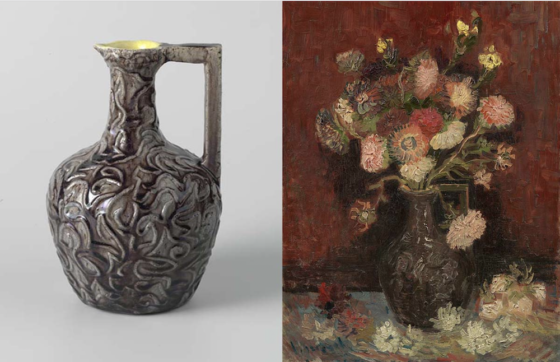The vase that is not a vase: objects in Van Gogh’s work tell a story


The everyday objects Vincent van Gogh used in his paintings were indeed everyday and therefore disposable but their identification provides clues to Van Gogh’s working methods and even changed the place of origin of one of his works, a new exhibition shows.
Only three of the original objects Van Gogh painted survive – a Norman copper milk jug, a small French earthenware liqueur jug and a small stoneware Japanese style vase – but what, art historian Alexandra van Dongen wondered, could the other objects tell her about the painter and his methods?
Although not much remains unexplored when it comes to the life and work of one of the Netherland’s best known painters, Van Dongen found that the objects Van Gogh used in his paintings had not been studied in depth.
To find out more she studied the ceramic and glass shards from everyday kitchen ware that were dug up from the garden of Van Gogh’s parents rectory in Nuenen and checked out French second hand markets.
‘The search for vases, pots and pans and kettles was great fun and led to all sorts of collections, collectors and French markets where I picked up identical 19th century objects for a song,’ Van Dongen told het Parool.
One of Van Dongen’s most important discoveries changed the perception of where Van Gogh painted his Still life with Potatoes. Originally thought to have been painted in Nuenen, the identification of the French earthenware pan helped put it its origin in Paris.
‘It turned out the pan had been made in Vallauris and that just about every French kitchen had one,’ Van Dongen said. A closer study of the canvas also showed the stamp of the Parisian art supplies firm Tasse et L’Hôtel, putting it firmly in Van Gogh’s Parisian period, and in 1885, not 1886.
Sunflowers
She also found that Van Gogh’s many vases for his sunflowers often weren’t vases at all but beer jugs, majolica jugs and in one case a storage jar for confit de canard. These were all tell tale clues to where Van Gogh was at the time and what his environment looked like.
Van Dongen’s urge to dive into the origins of objects depicted on paintings is not new. ‘In 2012 I discoverd that a pot painted by Jan van Eyck in the 15th century was a apothecary’s pot from Damascus. That made it the earliest known depiction of Arabic ceramics in European art. That kind of discovery makes me really happy,’ she told het Parool.
Closer to Vincent – Everyday objects in the work of Vincent van Gogh is on at Vincent van GoghHuis in Zundert until October 30.
Thank you for donating to DutchNews.nl.
We could not provide the Dutch News service, and keep it free of charge, without the generous support of our readers. Your donations allow us to report on issues you tell us matter, and provide you with a summary of the most important Dutch news each day.
Make a donation